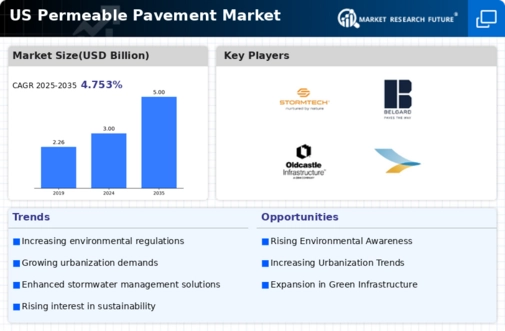The pervious pavement market is currently characterized by a dynamic competitive landscape, driven by increasing environmental regulations and a growing emphasis on sustainable construction practices. Key players such as Oldcastle Infrastructure (US), Pervious Solutions (US), and NexGen Paving (US) are strategically positioning themselves through innovation and regional expansion. Oldcastle Infrastructure (US) has focused on enhancing its product offerings by integrating advanced materials that improve permeability and durability, thereby appealing to environmentally conscious consumers. Meanwhile, Pervious Solutions (US) has been actively pursuing partnerships with local governments to promote the adoption of permeable paving solutions in urban development projects, which reflects a broader trend towards collaboration in the industry. Collectively, these strategies are shaping a competitive environment that prioritizes sustainability and technological advancement.
In terms of business tactics, companies are increasingly localizing manufacturing to reduce transportation costs and enhance supply chain efficiency. The market appears moderately fragmented, with several players vying for market share while also collaborating on projects that require specialized expertise. This competitive structure allows for a diverse range of products and services, catering to various customer needs and preferences.
In October 2025, Oldcastle Infrastructure (US) announced a new initiative aimed at expanding its manufacturing capabilities in the Midwest, which is expected to enhance its supply chain efficiency and reduce lead times for customers. This strategic move is likely to bolster the company’s competitive position by enabling it to respond more swiftly to regional demand fluctuations. Furthermore, this expansion aligns with the growing trend of localized production, which is becoming increasingly important in the context of sustainability and reduced carbon footprints.
In September 2025, Pervious Solutions (US) launched a new line of eco-friendly permeable pavers designed specifically for residential applications. This product line not only addresses the rising consumer demand for sustainable building materials but also positions the company as a leader in innovation within the residential sector. The introduction of these pavers is expected to capture a significant share of the market, particularly among environmentally conscious homeowners looking for effective stormwater management solutions.
In August 2025, NexGen Paving (US) entered into a strategic partnership with a leading technology firm to develop AI-driven solutions for optimizing pavement installation processes. This collaboration is indicative of a broader trend towards digitalization in the industry, where technology is leveraged to enhance operational efficiency and reduce costs. By integrating AI into its operations, NexGen Paving (US) is likely to improve its service delivery and maintain a competitive edge in a rapidly evolving market.
As of November 2025, the competitive trends in the pervious pavement market are increasingly defined by digitalization, sustainability, and the integration of advanced technologies. Strategic alliances are playing a crucial role in shaping the current landscape, enabling companies to pool resources and expertise to drive innovation. Looking ahead, it is anticipated that competitive differentiation will evolve, with a shift from price-based competition towards a focus on innovation, technology, and supply chain reliability. This transition underscores the importance of adaptability and forward-thinking strategies in maintaining a competitive advantage in the market.















Leave a Comment